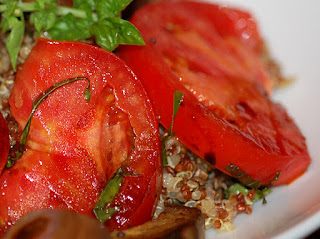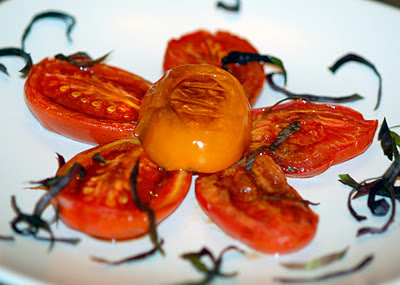Also lots of other problems. I don't have time to go into them now. Too busy plotting our next excursion to acquire more curry leaves.
So here is my advice to you: Buy them. Borrow them. Don't necessarily steal them from old ladies because I can't bring myself to publicly condone that sort of behavior (although obviously if an old lady had ALL the curry leaves in the area and utterly refused to give you any when you gently encouraged her to share by pulling as hard as you could on the bagful that she was carrying, an extra-hard tug might be justifiable). If you're in Berkeley, Vik's has them (as well as most or all of the ingredients for the dal below); in NYC, go to the little store underneath Sigiri (after stuffing yourself at Sigiri, of course) and look in the refrigerator case.
Anywhere else, look for an Indian spice store somewhere and ask them if they know where you might find some in the area. (If you've had curry leaves before, note that it is understandable yet nonetheless considered poor form to grab people urgently by the collar as you do this.) The leaves will keep well in the freezer without losing much taste for up to a month or so. And they're DIVINE. Have I mentioned that? Divine.
What to do with your curry leaves, once you acquire them? Heat some olive oil in a pan, add several fresh curry leaves and saute for a couple minutes, then add other things. Cook and eat. Repeat as needed. Or make this (I'm sorry, that conjunction was entirely incorrect. Allow me to rephrase: AND make this).
Sri Lankan Dal Curry over Yellow Basmati Rice
I have no idea where we found the original recipe that gave rise to this dish (so let me just go ahead and thank anyone on the planet who knows how to cook Sri Lankan dal, for making the world a much better place), but we've adapted it over the last few years to come as close as possible to the lentil curry at the incomparable Sigiri in New York. It looks much more complicated than it is, because of all the spices, but it's actually a very straightforward recipe once you have the ingredients on hand.Dal Ingredients
Olive oil
1 medium yellow onion, chopped
2 large cloves garlic, pressed
1 tsp black mustard seeds
1/4 tsp yellow mustard seeds
2 stemfuls of curry leaves, washed and dried (when in doubt, err on the side of more rather than less)
1 tsp Aleppo pepper (or 3/4 tsp if you want to keep it mild; can sub a minced hot pepper)
1 1/2 cups toor dal (small yellow lentils), picked through carefully, rinsed, and drained
1 cinnamon stick
1 tsp turmeric
1/4 tsp ground fenugreek
3 cardamom pods, cracked
2 cloves, lightly crushed
1 can coconut milk, divided (reserve 1/3 cup for the end)
Salt
Rice Ingredients
Olive oil
1 tbsp sliced almonds
2 tbsp golden raisins
4 curry leaves (optional)
2 generous pinches saffron
1 1/2 cups white basmati rice
Heat a generous glug of olive oil in a medium-to-large pot. Add the onion and saute over medium heat until soft, then add the garlic. Saute for a minute more, then add the mustard seeds, curry leaves, and Aleppo pepper. Saute for another minute or two, stirring occasionally.
Add the dal, cinnamon stick, turmeric, fenugreek, cardamom, cloves, most of the coconut milk (reserving 1/3 cup), and 2 cups of water. Stir, cover, and bring to a simmer. Turn the heat down to low and simmer rapidly until the dal is tender (about 20-25 minutes), stirring every 10 minutes or so. You may want to leave the lid ajar for the last ten minutes or so if it seems very soupy (or leave well-covered if it seems to be drying out).
Meanwhile, heat a teaspoon or so of olive oil in a small pot over medium heat. Add the curry leaves and almonds and saute for a couple of minutes until they just start to turn fragrant (but before the almonds have really started to brown). Add the saffron and golden raisins and stir a few times, then add the rice and stir to coat evenly. Pour in just over 1 3/4 cups water, cover, and bring to a boil. Turn the heat down to low and simmer for 15 minutes or until the rice is cooked through (the ratio of water to rice is going to change slightly depending on your rice and stove and pot, so check a few minutes before it should be done and add a tablespoon more water if necessary, or leave the lid ajar to boil off excess liquid).
When the lentils are tender and soft, turn off the heat, stir in the last 1/3 cup of coconut milk, and season to taste with salt. Remove the cinnamon stick, cardamom pods, and cloves (as far as we can tell, it is only possible to find three out of four of the smaller whole spices at a time. If you're worried that your dining companions will stare at you accusingly if they happen upon a particularly pungent bite, tell them that whoever finds the last one "wins." Kind of like a King Cake, only with a cardamom pod where the plastic baby should be.)
Serve the lentils over the rice, with a side of sauteed greens.
Serves 3-4.



























